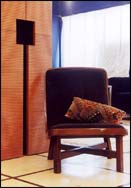caring for your interiors isn’t
really that difficult; it just requires a little know-how to prevent them from
looking faded and lacklustre. your furniture, upholstery, paintings and tiles
are most likely to look old and dull after a while. with a little timely
intervention, however, you can protect them from becoming derelict victims of
age and time. try these simple tips to ensure they look as good as possible for
as long as you need them.
for your
furniture

until recently, the average person’s perception of furniture
has been that it should be functional. now that mind set has changed —
most people think of their furniture as an expression of their personalities,
and want to maintain it well.
furniture is most commonly made of
wood, however, it could have other components — like metal, or even
fabric. you need to survey all the different kinds of furniture in your home,
before you actually start on a maintenance plan. what can harm your furniture?
the environment for one, can affect the life of your furniture. light,
particularly, ultra-violet, can cause cumulative damage to wooden furniture.
light is a potent source of energy that can gradually but surely
damage the components in wood. you can protect your furniture from harsh lights
by placing it out of the way of direct sunlight. here’s where curtains or
blinds come to the rescue. blinds evenly diffuse direct sunlight throughout a
room. another tip is to turn lights off when they’re not in use. you can
keep uv rays out by using a uv filter film on your windows. interior designer
sanjay gonzalves of space schematics says, “furniture that is constantly
exposed to harsh light can be adversely affected; however, wood is your safest
bet because wooden furniture usually requires very little maintenance. a little
care can ensure longevity.”
atmospheric moisture too, can have
its effects; wood responds to humidity by expanding or contracting to maintain
equilibrium. too much exposure to humidity can also encourage mould. furniture,
especially that made of wood and leather, is also prone to insect attack. you
can prevent this by regular polishing, approximately once a year.
use wax, available at any hardware store, to maintain varnished
furniture. dust and grime are enemies of furniture; they can cause scratches on
finished surfaces. dust your furniture regularly with a soft cotton cloth, or a
slightly damp cloth, or a brush to maintain that sleek look. avoid using feather
dusters as they tend to mar fragile veneers or get stuck in
cracks.
if you have brass furniture, you probably already know how
soon it tarnishes. you can use a coat of lacquer to enhance the longevity of
brass furniture and artefacts. when choosing the lacquer, stay away from the
variety that contains ammonia as this causes long-term corrosion.
advises gonzalves, “to protect wrought iron and brass
furniture, treat it with red oxide first — this prevents it from rusting.
next, polish it. then use a matte spray as a cover to give your furniture a dull
sheen. if you want a high gloss, use several coats.”
treating that
terrazzo
tiles require constant care. and there’s probably no
worse sight than broken or neglected tiles. apart from accumulating dust and
grime, tiles are also prone to chipping or cracking. design consultant anuradha
sridhar has a tip for cleaning tiles, “use bleaching soda on your tiles as
it has cleaning and disinfecting properties. if grime is accumulating in the
cracks between tiles, swab them with diluted hydrochloric acid using a small
brush. this removes the grime and gives the corners of your tiles a white, even
look.”
another concern is looking after floor tiles. marble
floors are prone to stains, as marble is porous. you can preserve the beauty of
marble floors with an annual polishing regimen using tin oxide. if you have
ceramic tiles, disinfectant cleaners works best. gonzalves says, “if you
are touching up the joints of your tiles, mix white cement and fevicol in a
1:1.5 proportion and apply this to the joints.”
preserving
paintings

paintings are meant to enhance the charm of a room, but they can
be genuine eyesores when they fall prey to dust and moisture.
while
dusting paintings, don’t use a feather duster as it can cause scratches.
instead, use a soft-bristled brush, like a make-up brush.
moisture
is enemy number two. moisture can seep in through the back and cause irreparable
damage. moisture leads to fungus and discolouration. make sure the wall that
your painting adorns is dry and chemically cured. some paintings come without
frames. these are particularly vulnerable. you can protect these by coating them
with a solution called matte. gonzalves says, “matte is almost like a
laminative. it gives paintings a thin transparent veneer while protecting them
from dust and stains. one coat can protect your paintings for about five
years.”
bright lights and temperature fluctuations can also
cause a gradual deterioration of canvas paintings. avoid hanging canvas
paintings above air conditioning or heating vents; and keep them away from
direct sunlight. don’t use air fresheners, pesticides or furniture sprays
near paintings. if you have to, move your paintings away, temporarily. while
carrying them away, make sure you remove sharp pieces of jewellery that could
graze them, and always carry them with the image side facing you.
caring for
curtains

curtains are usually made from fabric. their deterioration is
usually due to light, tem-perature, humidity, dust and pollutants, or a
combination of all these. light can cause the colour of curtains to fade. using
starch on your curtains can cause them to turn yellow. however, curtains are
necessarily exposed to light, as it is their primary function to shut out light;
you can’t do much about that. one way to handle this is to rotate
different sets of curtains (change them periodically). make sure your curtains
are always clean and free of dust by vacuuming them once a week.
gonzalves says, “glaze your curtains with scotch guard. this
is a treatment for fabrics; it protects your fabrics from water and pollution.
it enhances the life of your curtains, you can also use it on your
upholstery.” the effect of scotch guard lasts for about six months.
similarly, you can also use a solution called v-max on your curtains to prevent
staining. v-max needs to be touched up every 18 months. be very careful before
you use any chemical on your curtains, always do a little research to see how it
will affect your fabrics.

